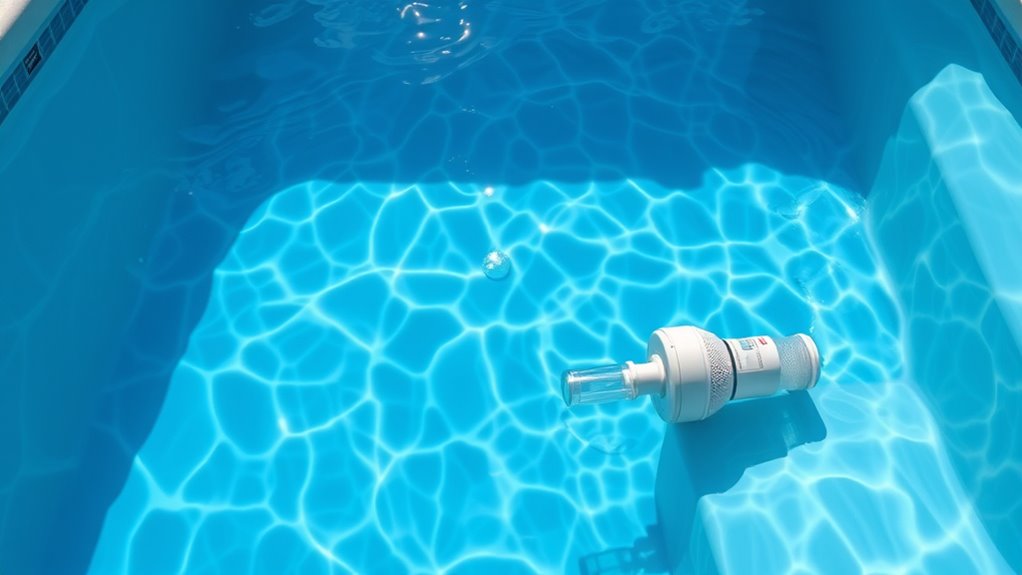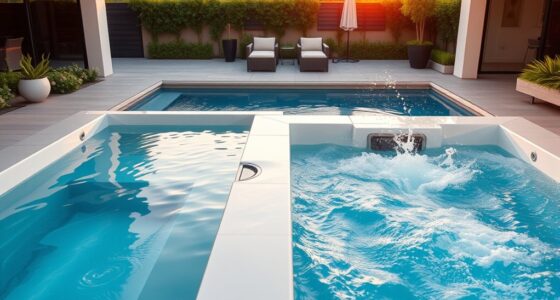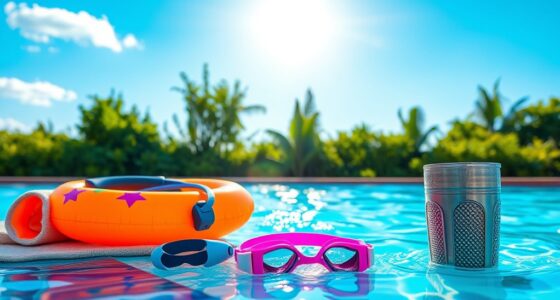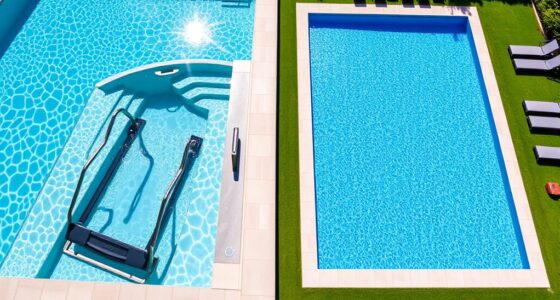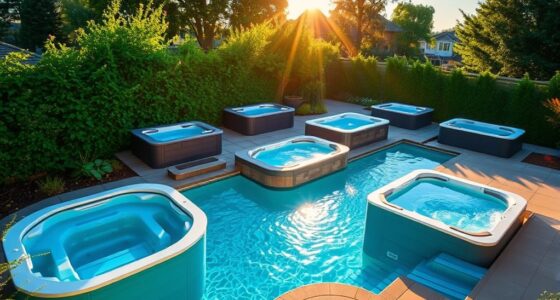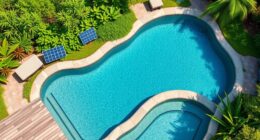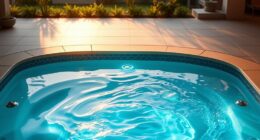To keep your swim spa safe and clear, regularly balance chlorine levels between 3-5 ppm using test strips or digital testers, and adjust as needed to prevent bacteria or skin irritation. Clean filters monthly to maintain water clarity and prevent equipment problems, rinsing or soaking them in cleaner if necessary. Proper water care involves consistent testing, cleaning, and monitoring—keep your water pristine and enjoy a healthier swimming experience by following expert tips.
Key Takeaways
- Regularly test and maintain chlorine levels between 3-5 ppm to ensure effective sanitation.
- Clean filters monthly with a hose and cleaner, and replace every 1-2 years for optimal filtration.
- Prevent water issues by balancing chemicals and avoiding overuse or underuse of sanitizers.
- Proper filter care supports water clarity, water flow, and prolongs equipment lifespan.
- Consistent water care practices ensure safe, clear, and healthy swim spa conditions.

Maintaining clean and balanced water in your swim spa is crucial for safe and enjoyable use. Proper water care ensures you can relax and exercise without worrying about bacteria, algae, or cloudy water. To achieve this, you need to pay attention to chlorine balancing and filter maintenance. These are fundamental steps that keep your water fresh and clear, preventing potential health issues and extending the lifespan of your equipment.
Chlorine balancing is the backbone of water sanitation. You want to keep chlorine levels steady, usually between 3 to 5 parts per million (ppm), to effectively kill bacteria and neutralize contaminants. If your chlorine is too low, harmful microorganisms can thrive, making the water unsafe. Conversely, excessive chlorine can cause skin irritation and unpleasant odors. To maintain proper chlorine levels, test your water regularly—at least once a day when the spa is in heavy use, and a couple of times weekly otherwise. Use test strips or a digital tester for accuracy. If your chlorine levels are off, adjust them accordingly: add chlorine or use a stabilizer to prevent rapid dissipation. Remember, consistent testing and adjustment are key to avoiding water quality issues.
Alongside chlorine balancing, filter maintenance plays a crucial role in water care. Your swim spa’s filter traps dirt, oils, and other debris that can cloud the water and promote bacteria growth. A dirty filter reduces water flow, hampers filtration efficiency, and makes it harder to keep the water clean. To prevent these problems, clean your filter regularly—typically once a month or more frequently if your spa sees heavy use. Remove the filter and rinse it thoroughly with a garden hose to wash away debris. For deeper cleaning, soak the filter in a filter cleaner solution, following the manufacturer’s instructions. Always replace filters according to the manufacturer’s schedule, usually every 1 to 2 years, to ensure ideal filtration. Proper filter maintenance not only keeps your water clear but also helps maintain the overall health of your swim spa’s components. Additionally, filter quality can impact how effectively your filtration system performs over time.
Frequently Asked Questions
How Often Should I Test My Swim Spa Water Chemistry?
You should test your swim spa water chemistry at least twice a week to guarantee proper chemical balancing. Regular water testing helps you catch imbalances early, keeping the water clean and safe. If you notice heavy use or after adding chemicals, test more frequently. Consistent testing is key to maintaining crystal-clear water, preventing problems, and ensuring your swim spa stays inviting and healthy for every swim session.
Can I Use Regular Pool Chemicals in My Swim Spa?
Think of your swim spa’s water as a delicate dance that needs harmony. You might wonder if regular pool chemicals can keep the rhythm, but they often aren’t compatible with spa water balancing. Using the wrong chemicals can upset the dance, leading to cloudy water or equipment issues. Always check pool chemical compatibility, and opt for products designed specifically for spas. This guarantees your swim remains smooth and inviting.
What Is the Best Way to Prevent Algae Growth?
To prevent algae growth, you should focus on algae prevention techniques like maintaining proper water circulation and keeping the water balanced. Regularly run your pump to ensure consistent movement, which discourages algae from settling. Additionally, shock your swim spa weekly and monitor your chemical levels to prevent nutrient buildup. Consistent water maintenance and good circulation are key to keeping algae at bay and maintaining clear, healthy water.
How Do I Troubleshoot Cloudy or Murky Water?
Imagine peering into your spa, only to find murky water clouding your view. To troubleshoot, first check if your spa cover is properly maintained—dirt or debris can contribute to cloudiness. Next, inspect your filter cleaning routines; a dirty filter won’t effectively clear the water. Regularly clean or replace filters, and ensure your spa cover stays in good condition to keep water clear and inviting.
Are There Eco-Friendly Water Care Options Available?
You’re probably wondering if eco-friendly water care options exist. Yes, they do! You can use biodegradable sanitizers that effectively disinfect without harsh chemicals. Natural filtration systems also help keep your swim spa clean by reducing reliance on synthetic filters. These options are safe for your family and the environment, making your swim spa maintenance more sustainable. Give them a try for cleaner water and peace of mind.
Conclusion
Taking care of your swim spa is like tending a garden—you need the right tools, regular attention, and a bit of patience. Keep your water balanced with proper chemicals, maintain your filters, and stay vigilant for signs of issues. When you do, your swim spa becomes a sparkling oasis where you can relax and refresh anytime. With a little effort, you’ll guarantee your swim spa stays vibrant and inviting—your personal paradise just a few simple steps away.
